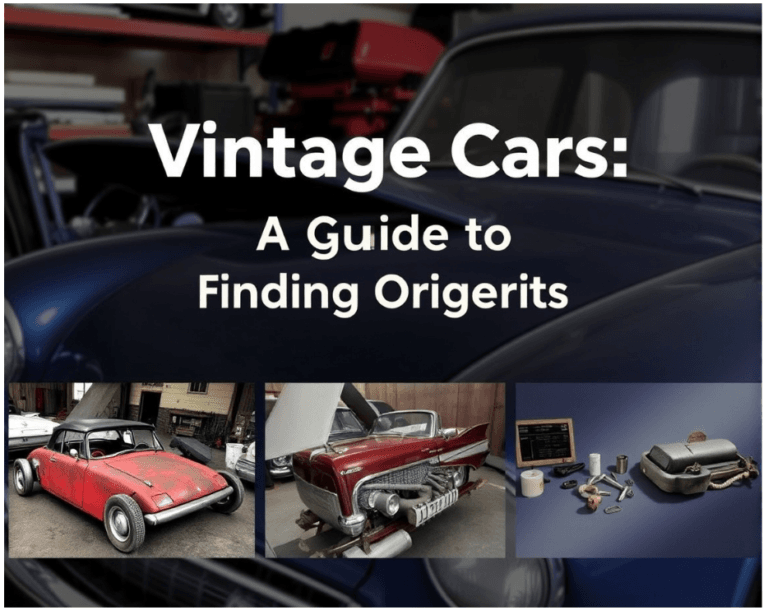Owning a vintage car is not just about possessing a piece of history—it’s about preserving it. Whether you’re an enthusiast of classic beauties like the Ford Mustang or the Cadillac Eldorado, sourcing original parts for your vehicle can be a daunting task. From restoring these timeless machines to getting them road-ready, the journey is as rewarding as it is challenging.
But, how do you find authentic parts that maintain the integrity of these iconic vehicles? Let’s try to learn in this blog.
Contents
Understanding the Value of Original Parts
Original parts play a critical role in maintaining the authenticity of a vintage car. When you replace old parts with replicas, you risk altering the vehicle’s value and performance. Purists argue that nothing beats the feel and sound of a car equipped with its original engine, brakes, or transmission. This holds for casual collectors and those serious about participating in car shows or auctions.
Why Original Parts Matter:
- Retain the vehicle’s historical accuracy.
- Maintain higher resale value.
- Ensure the classic performance is untouched.
Where to Source Authentic Vintage Parts
Sourcing authentic vintage car parts requires patience, research, and connections. Many original components are no longer in production, so you’ll need to explore alternative routes. Here’s where to begin:
- Classic Car Shows & Auctions
These events are gold mines for vintage car enthusiasts. Not only can you find rare parts, but you can also meet fellow collectors who may be willing to sell or trade. - Specialty Classic Car Parts Dealers
Some specialty dealers focus exclusively on classic car parts. These dealers often have access to rare, hard-to-find components, such as engines, body panels, and interiors, sourced from other vintage vehicles or specialized manufacturers. Don’t forget to inquire about classic car transport company that have established relationships with these dealers, ensuring your valuable parts and vehicles are moved safely and without damage.
- Dealerships and Classic Car Parts Distributors
A few dealerships still maintain inventories of vintage parts or have connections to reliable sources. Some distributors focus exclusively on classic car parts, ensuring you’re getting the real deal. - Professional Restorers
Established vintage car restoration shops can often help you locate hard-to-find original components. Some restorers have their stockpile of rare parts, or they know where to get them. - Online Forums and Communities
Many dedicated vintage car communities exist online. Enthusiasts and sellers often frequent these platforms, offering advice and original parts for sale. These forums are also a great place to get recommendations on the best vehicle transport companies that specialize in vintage and classic cars, as other users often share their experiences and recommendations.

Safely Transporting Your Vintage Car
Finding the right parts is just the first step—keeping your car in pristine condition during transport is another challenge. Working with the best vehicle transport company is essential if you need to relocate your classic car, whether for restoration or a big event Unlike regular cars, vintage automobiles require specialized handling during transportation to prevent any damage to their delicate parts.
A good transport company will:
- Use enclosed trailers to protect against weather and road debris.
- Offer secure strapping that prevents scratches or dents.
- Provide tracking options so you know exactly where your car is at all times.
One often overlooked aspect is how the car transport company prepares your car for transport. Since vintage cars are irreplaceable, you’ll want to ensure your vehicle is fully covered during the entire journey. A good company will offer robust insurance options tailored to vintage or high-value cars.
How to Identify Genuine Vintage Parts
One of the biggest concerns for vintage car owners is ensuring the authenticity of the parts they’re purchasing. How can you tell if the part is truly original and not a replica? Here are some telltale signs to help you verify authenticity:
- Manufacturer’s Marks: Many original parts will bear the stamp or marking of the manufacturer, often with serial numbers or factory codes.
- Wear and Tear: Real vintage parts often show signs of aging, whether it’s light rusting, fading, or general wear. If a part looks brand new, be cautious—it may be a modern reproduction.
- Documentation: Authentic parts often come with paperwork or certificates verifying their origin. If you’re buying a high-value part, ask for documentation from the seller.
Quick Tips to Keep in Mind:
- Original parts maintain the value and authenticity of your car.
- Visit car shows, online forums, and specialty dealers for sourcing rare parts.
- Choose a reputable transport company with experience in handling vintage vehicles.
Conclusion
Finding original parts for vintage cars takes effort, but the results are worth it when your vehicle runs and looks as it did decades ago. Whether restoring or preparing for a trip, working with a trusted transport company is essential. For the ultimate guide to the road trip, ensure your vintage car is handled by professionals to avoid damage to its delicate, irreplaceable parts. Reliable transporters protect your classic during relocations for restoration or events, keeping it road-ready and in top shape.
